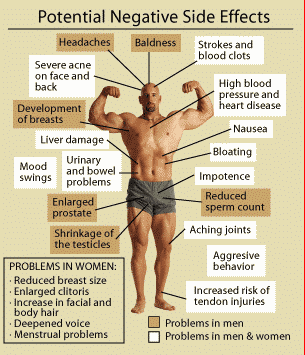 Anabolic Steroids are synthetic versions of testosterone, the hormone that is produced in the male testicles and is reposnsible for a man looking like a man . They are often used to promote growth of muscle and bones because of their ability to increase cell growth and division but can also increase growth in other bodily tissues as well. Normal body processes are catabolic or your proteins get used, while anabolic means that proteins are created.
Anabolic Steroids are synthetic versions of testosterone, the hormone that is produced in the male testicles and is reposnsible for a man looking like a man . They are often used to promote growth of muscle and bones because of their ability to increase cell growth and division but can also increase growth in other bodily tissues as well. Normal body processes are catabolic or your proteins get used, while anabolic means that proteins are created.
There are many different types of anabolic steroids and they each have a different combination of anabolic and androgenic characteristics. They are sometimes referred to as AAS or Anabolic-Androgenic Steroids. These are not to be confused with the “steroid cream” that a doctor gives you to put on a rash or poison ivy — those are derivitives of cortisol and they suppress out of control immune function which is often the cause of a rash. Those kinds of steroids are quite different and they will not bulk up muscles. As a matter of fact, misuse of corticosteroids or cortisone creams will cause you to gain fat — and a lot of it.
First discovered in the 1930’s anabolic steroids have many medicinal uses. Bone growth, appetite, puberty and muscle growth can all be stimulated with use of anabolic steroids. They have also been proven successful in treatment for chronic wasting in cancer and AIDS patients. Anabolic steroids work for these purposes because they increase protein synthesis, muscle mass and strength. On the other side of the spectrum, however, are the negative effects that overuse of anabolic steroids can produce. These include increases in LDL cholesterol and decreases in HDL cholesterol, high blood pressure and liver damage.
These chemicals are controversial because athletes have found benefits in using them for training purposes. Thus, anabolic steroids have also had many effects on competitive sports. Because of the potential health effects of anabolic steroids, they are a controlled substance in the United States and other countries.
Use of anabolic steroids may go back as far as ancient Greece. Here it is believed that they used natural substances that promoted both androgenic and anabolic effects. Modern advances in anabolic steroids, however, began in Germany when scientists in the 1930’s were looking for ways to increase the abilities of national athletes. Up until the 1980’s many people thought that the effects of a placebo effect, but there were many inconsistencies in the studies.
In 1990, the United States placed Anabolic Steroids on the list of controlled substances. It was around this time that many drug companies in the United States stopped producing anabolic steroids (or at least stopped marketing them in the United States). An effect of this was an emergence of counterfeit anabolic steroids – some of which were extremely harmful.
While anabolic steroids are controlled in the United States and very strictly regulated in other countries, they are readily available in some countries (including Mexico and Germany). As with some other illegal drugs, there is a strong movement in the United States to remove the regulations on anabolic steroids.
What do these drugs do that makes them in demand:
Anabolic steroids have both anabolic (tissue building) and androgenic (male enhancement) effects. How they balance out with each other depends on the specific make up of the hormone in question. In general, anabolic effects include the promotion metabolism and the building of tissues and androgenic refers to the promotion of masculine effects. Ideally, anabolic steroids should be able to have the most anabolic effects with the fewest androgenic effects. The search is on for a successful anabolic steroid that has no androgenic effects. Finding the right balance is what is difficult.
As mentioned earlier, anabolic refers to how the steroid rebuilds or increases body tissues. The effects of anabolic steroids vary depending on its specific makeup. Generally speaking, what happens is that the steroids bind to the androgen receptor, but they do it at different degrees. The degree of this binding on the androgen receptors determines the effect on the protein synthesis, glygogenolysis, or transcription of the receptors which, in turn, affects the type of growth of the tissue in question. In addition to this building of tissues, anabolic steroids also reduce catabolism. Anabolic steroids do this by reducing recovery time through the blocking of cortisol.
Some specific anabolic effects include a visible increase in muscle mass, strength, appetite and bone structure. It can also increase the stimulation of bone marrow and red blood cell production.
The androgenic effects (also referred to as virilizing effects) take on a very different form. They include clitoral growth in females and penis enlargement in male children. There can also be an increase in body hair including pubic, facial, chest and limb hair. Anabolic steroids can also increase the size of the vocal cord which deepens the voice.
Androgenic effects also include the increase of the libido and the suppression of sex hormones.
Administration of Anabolic Steroids
Anabolic steroids can be administered in oral, injectable or transdermal forms. Oral forms are very convenient, but they often need to be chemically altered so that it reaches the bloodstream before the liver breaks it down. Oral anabolic steroids can often be very hard on the liver and may even cause hepatotoxicity when taken in high doses or for long periods of time. The injectable anabolic steroids are often put right into the muscle tissue and the transdermal forms come in creams, gels or patches that are administered to the skin.
Medical Uses of Anabolic Steroids
Anabolic steroids have been researched for medicinal purposes since the middle of the twentieth century. The most popular medical use for steroids is to help counter the effects of chronic wasting by stimulating appetite and increasing muscle mass. However, they have many different and successful uses. These include the following:
• Bone Marrow Stimulation: Anabolic steroids are now being replaced by synthetic proteins.
• Growth Stimulation: Since the 1980’s use of anabolic steroids has been replaced with growth hormones instead.
• Hormone Replacement Therapy: This helps men with low levels of natural testosterone.
• Puberty Induction: While testosterone is most widely used, anabolic steroids have been used to help boys who have extreme delays in the onset of puberty.
Other Uses Anabolic Steroids
Anabolic steroids have become very controversial because of the common use by athletes who want to gain a competitive edge, particularly in professional sports. Most of these sports now prohibit the use of steroids by their athletes. Additionally, high school athletes are using them as well to gain that competitive edge.
Side effect can occur whether the steroids are used for medicinal or other reasons. These include:
• high blood pressure
• increased total cholesterol levels
• increased acne
• hair loss and baldness
• prostate cancer
• liver damage (often caused by high doses of oral administration)
• excessive growth of oral gums
There are specific side effects in males. These include gynocomastia which is the appearance of female characteristics including breast development, sexual disfunction and infertility and shrinking of the testicles (testicular atrophy).
In females, the side effects include an increase in body hair, a deepening of the voice, an enlarge clitoris and a decrease in menstrual cycles.
Adolescents can experience stunted growth, quickened maturation of the bones, hypergonadism, increased body hair and precocious sexual development.
Anabolic steroids might make a person stronger and faster but overall they gradually destroy the body when used for those purposes. When used for mediacl reasons they can be very helpful and often curative for certain diseases.


